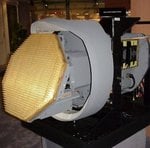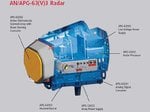Sgt. Pappy
Airman 1st Class
- 197
- Jun 7, 2006
It was only recently when the F-15 was finally fitted with the newest of AESA radar systems the U.S. has to offer - the APG-63(V)3.
From what I've managed to gather, there's virtually no information on this version of the -63 which I could find.
My question is how it stacks up against similar radar systems around the world, and more specifically, how an F-15 fitted with said radar would stack up against something like a Rafale, Typhoon or Super Hornet.
The Super Hornet itself is easiest to compare as I've found more info on its APG-79; a system that is probably not as good as the -63(V)3 (pure speculation, given that the -63(V)3 is apparently an F-15 radar system with APG-79 tech). The Super Hornet is claimed to have a small RCS inthe magnitude of around 0.1 sq.m while the F-15 has a gigantic 15-25 sq. m RCS. These are clean figures, however, and when the two aircraft carry missiles, their RCS is to go up dramatically. Still though, it's likely that the Super Hornet would still have a tiny RCS compared to the Eagle. Thus, I've come to question whether the F-15's impressive new radar system is offset by its humongous RCS.
Would an F-15 fitted with the APG-63(V)3 be able to take down an F/A-18E with an APG-79? Would the two aircraft be able to track each other far before within firing range? Or would an F-15 simply not know what hit it?

From this chart I've found, the -63(V)2 is similar in performance to the -79. Given the Hornet's small RCS, it looks like the Hornet has the advantage until the -63(V)3 was installed. The diagram simply states 'Detection/Tracking Range'. I'm not sure as to what mode the radar systems were assumed to be in when the graph was plotted.
From what I've managed to gather, there's virtually no information on this version of the -63 which I could find.
My question is how it stacks up against similar radar systems around the world, and more specifically, how an F-15 fitted with said radar would stack up against something like a Rafale, Typhoon or Super Hornet.
The Super Hornet itself is easiest to compare as I've found more info on its APG-79; a system that is probably not as good as the -63(V)3 (pure speculation, given that the -63(V)3 is apparently an F-15 radar system with APG-79 tech). The Super Hornet is claimed to have a small RCS inthe magnitude of around 0.1 sq.m while the F-15 has a gigantic 15-25 sq. m RCS. These are clean figures, however, and when the two aircraft carry missiles, their RCS is to go up dramatically. Still though, it's likely that the Super Hornet would still have a tiny RCS compared to the Eagle. Thus, I've come to question whether the F-15's impressive new radar system is offset by its humongous RCS.
Would an F-15 fitted with the APG-63(V)3 be able to take down an F/A-18E with an APG-79? Would the two aircraft be able to track each other far before within firing range? Or would an F-15 simply not know what hit it?
From this chart I've found, the -63(V)2 is similar in performance to the -79. Given the Hornet's small RCS, it looks like the Hornet has the advantage until the -63(V)3 was installed. The diagram simply states 'Detection/Tracking Range'. I'm not sure as to what mode the radar systems were assumed to be in when the graph was plotted.



